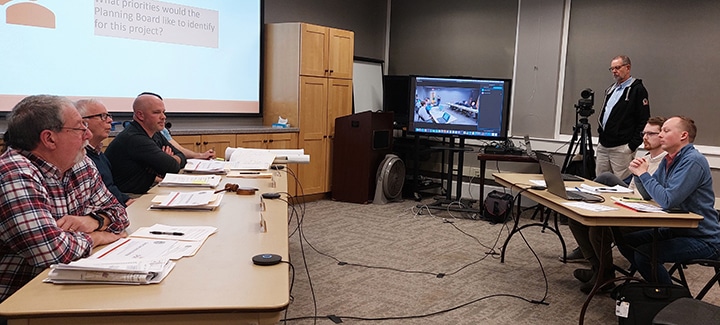The Planning Board listens to a presentation by Pioneer Valley Planning Commission planners Kyle Finnell and Aodhan Hemeo-McMahon on a proposed Center Town District.
Reminder Publishing photo by Sarah Heinonen
EAST LONGMEADOW — The possibility of a multi-use district in the center of town was resurrected at the Planning Board meeting on March 19.
The town’s Resilient Master Plan, adopted in 2021, set certain goals for the town’s center, including making it a hub for economic development and improving walkability. The plan also called for creating more diverse housing stock.
The idea for a mixed-use district focusing on the rotary had been in the initial stages of development in 2022, spearheaded by then-Planning and Community Development Director Bailey Mitchell. After pushback from residents regarding the possibility of redeveloping Center Field and concerns about taller buildings along Shaker Road, as well as more urgent matters taking precedent, the initiative was put on the back burner.
This time, the town is pursuing the Center Town District differently than it had in 2022. Whereas the plan then was to create an overlay district, Christensen explained that this district would rezone the area within roughly a mile of the rotary to allow for multiple uses, such as residential, commercial and open space. Private property in the district would be rezoned as the properties come up for sale. Christensen acknowledged that it may take quite some time to rezone the entire district but said the variety of uses may make the properties more desirable when being sold.
Rather than the district being created within the Planning Department, a steering committee, with the help of the Pioneer Valley Planning Commission, will draft a bylaw governing the district. The steering committee consists of five residents — Nicole Polite, Steven Graham, Carolyn Ferros, Dawn Starks and Jason Gumpert — most of whom are small business owners. Ralph Page and Robert Tirrell will serve as non-voting representatives from the Town Council and Planning Board, respectively. Deputy Town Manager Rebecca Lisi will be taking the lead in connecting plans for a Center Town District with other long-term projects in town.
“Resident engagement is critical,” said PVPC Senior Planner Kyle Finnell. While existing zoning and documentation will be analyzed and a bylaw draft drawn up this spring, feedback will be sought at two main community engagement sessions, one in May and another in late summer. Christensen said there will likely be more frequent, less formal public engagement opportunities throughout the process. The feedback will be incorporated into the bylaw drafts throughout the process. The draft will then go through the town’s bylaw review process before final adoption. While the PVPC estimated adoption by December, Christensen said that is optimistic, as bylaw review is a lengthy process.
The goal of the bylaw is to make the area around the rotary into “a thriving core” for the town with “a range of uses specific to a downtown,” said PVPC Planner Aodhan Hemeo-McMahon. He cited Northampton, Chicopee, Amherst and Easthampton as nearby examples of communities with “desirable downtowns.” Some of the aspects that make these downtown areas thrive include walkability, transit options, economic opportunity, activity and higher density with mixed-use properties — many of which are the same goals laid out in the Resilient Master Plan.
He said that more than half of the property within a mile radius of the rotary is zoned residential, with the vast majority of that being single-family homes. However, he also pointed out that there were “interesting pockets” of underused property or industrial properties. For a district to be feasible, the town would need to pursue what Hemeo-McMahon called “denser, smarter growth” in that area of town.
One way to accomplish this is through “smart growth zoning,” created by the state in 2004 to encourage municipalities to allow higher-density, affordable, mixed-use developments. The districts, which fall under Chapter 40R, are eligible for state funding, but must adhere to certain requirements. For example, the density requirements to be considered a 40R district would see eight single family homes, 12 townhouses, or 20 condominiums or apartments per acre. While the state has set guidelines for municipalities to have 10% or more of its housing stock be affordable units, 40R districts have a requirement of 20% affordable homes.
In the 20 years since the initiative began, the state has approved 40R district designations in more than 40 communities.
The funding for 40R districts includes an initial incentive payment ranging from $10,000 for up to 20 new housing units to $600,000 for more than 500 such units. After that, the town would receive $3,000 for every new housing unit built.
The steering committee’s initial role will be to determine if 40R is the right path for the town to pursue. If not, East Longmeadow can create a Center Town District through standard bylaw creation means. While there would be fewer restrictions, the same funding opportunities would not exist.
“It’s got to be right for us,” Christensen said of creating the 40R district. Otherwise, the steering committee will choose another route.
Planning Board Chair Russell Denver asked if the state’s 10% standard for affordable housing would be altered by the adoption of a 40R district. Finnell said that the threshold would not increase and that affordable units in the district would be included when considering the town’s housing affordability levels.
Denver went on to say that he would like to see improved walkability, more small businesses and “things that bring more life” to the rotary while maintaining recreational spaces such as Center Field. Planning Board member William Fonseca agreed and said maintaining open space is among his priorities. Denver added that the “perception” of safety in the area, which would improve its use at night, could be improved with better street lighting.
Resident William Preye how an “influx of students” would impact the School Department. Finnell said the state provides funding to municipalities for children living in 40R districts that are added to the school rolls. Former Planning Board member George Kingston noted that limits of the number of bedrooms in housing units within the district would largely quell such an influx.
While Preye said he the development sounded positive, he added, “A lot of people in town don’t know this is going on.” Finnell repeated that public outreach would be a large part of the process.
Brad Hoffman referred to a map of communities that had adopted 40R districts, including Northampton, Easthampton, Chicopee, Westfield, Ludlow, Holyoke and South Hadley. He said most of them were “neat little towns” even before creating the districts. He asked that updated information be provided regarding impacts to the economy in those towns. He also wanted to know what new businesses would be eligible for the district.
Dawn Starks’ husband, Sid Starks, said parking will be needed and suggested a parking garage. He also said developing industrial properties along the rail trail would be successful due to its popularity. He also floated limiting incoming businesses to local owners with a vested interest in the community.
“You need to go up in the center” of town, Kingston said. He said putting apartments above businesses is common, especially in his native New York.
A Springfield resident who said he was hoping to move back to East Longmeadow, wondered how such a district could not increase traffic congestion.
Dawn Starks commented after the meeting that East Longmeadow has always grown organically. For the first time, the town will be strategic in its development, she said.



